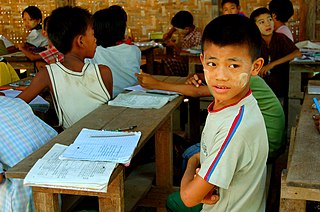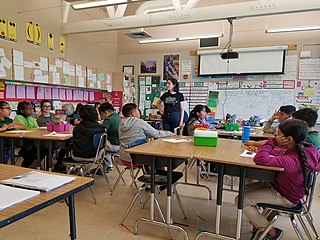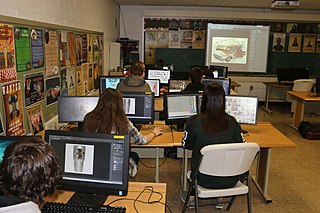
A student is a person enrolled in a school or other educational institution.

Education in the Netherlands is characterized by division: education is oriented toward the needs and background of the pupil. Education is divided over schools for different age groups, some of which are divided in streams for different educational levels. Schools are furthermore divided in public, special (religious), and general-special (neutral) schools, although there are also a few private schools. The Dutch grading scale runs from 1 to 10 (outstanding).

Gymnasium is a term in various European languages for a secondary school that prepares students for higher education at a university. It is comparable to the US English term preparatory high school or the British term grammar school. Before the 20th century, the gymnasium system was a widespread feature of educational systems throughout many European countries.

A middle school, also known as intermediate school, junior high school, junior secondary school, or lower secondary school, is an educational stage between primary school and secondary school.

A state school, public school, or government school is a primary or secondary school that educates all students without charge. Such schools are funded in whole or in part by taxation and operated by the government of the state.

A secondary school or high school is an institution that provides secondary education and also usually includes the building where this takes place. Some secondary schools provide both lower secondary education and upper secondary education, i.e., both levels 2 and 3 of the ISCED scale, but these can also be provided in separate schools.
Sixth grade is the sixth year of formal or compulsory education. Students in sixth grade are usually 11-12 years old. It is commonly the first or second grade of middle school or the last grade of elementary school, and the sixth school year since kindergarten.

Fourth grade is the fourth year of formal or compulsory education. It is the fourth year of primary school. Children in fourth grade are usually 9–10 years old.
Seventh grade is the seventh year of formal or compulsory education. The seventh grade is typically the first, second or third year of middle school. In the United States, children in seventh grade are usually around 12–13 years old. Different terms and numbers are used in other parts of the world.
Third grade is the third year of formal or compulsory education. It is the third year of primary school. Children in third grade are usually 8–9 years old.
Ninth grade is the ninth or tenth year of formal or compulsory education in some countries. It is generally part of middle school or secondary school depending on country. Students in ninth grade are usually 14–15 years old, but in some countries are 15–16.
Tenth grade is the tenth year of formal or compulsory education. It is typically the second year of high school. In many parts of the world, students in tenth grade are usually 15 or 16 years of age.
Eleventh grade is the eleventh year of formal or compulsory education. It is typically the third year of high school. Students in eleventh grade are usually 16–17 years of age.

Twelfth grade is the twelfth year of formal or compulsory education. It is typically the final year of secondary school and K–12 in most parts of the world. Students in twelfth grade are usually 17–18 years old. Some countries have a thirteenth grade, while other countries do not have a 12th grade/year at all.
Education in Norway is mandatory for all children aged from 6 to 16. Schools are typically divided into two divisions: primary and lower secondary schooling. The majority of schools in Norway are municipal, where local governments fund and manage administration. Primary and lower secondary schools are available free of charge for all Norwegian citizens as a given right.
Educational stages are subdivisions of formal learning, typically covering early childhood education, primary education, secondary education and tertiary education. The United Nations Educational, Scientific and Cultural Organization (UNESCO) recognizes nine levels of education in its International Standard Classification of Education (ISCED) system. UNESCO's International Bureau of Education maintains a database of country-specific education systems and their stages. Some countries divide levels of study into grades or forms for school children in the same year.
Year 8 is an educational year group in schools in many countries including England, Wales, Australia and New Zealand. It is the eighth or ninth year of compulsory education. It is known as First Year in Scotland. Kids in this year are between 12 and 13. This is generally equivalent to Seventh grade in the United States.
Year 7 is an educational year group in schools in many countries including England, Wales, Australia and New Zealand. It is the seventh full year of compulsory education and is roughly equivalent to grade 6 in the United States and Canada. Children in this year are between 11 and 12.










